Perplexus
Here is a classic tale of success and failure. In September of 1999, KID made a connection with Stewart Sims, who just started a new toy company called “NeXT ELECTRONIX,” a division of Playmates Toys. Years before, Stewart was responsible for bringing Rubik’s Cube to the western world. He felt that my game could be a real success, and wanted to create a whole new line from it. His goal was to have a working game ready by the American International Toy Fair in New York City, a mere five months away.
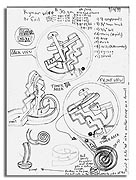
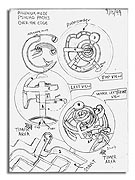
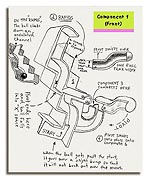
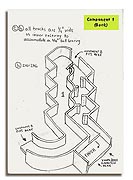
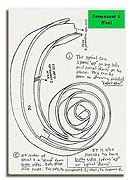
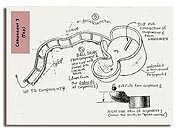
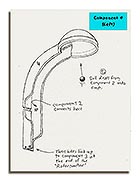
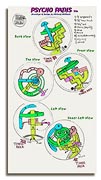
I was quite excited, not knowing how the future would unfold. The possibilities were huge. It was time to come up with the first design to fit into a 4″ sphere. Stewart gave me only three days to provide preliminary drawings. Very nerve wracking, and not nearly enough time to revise, improve, or even work out a really good solution, but I could not see this reality at the time. KID and I came up with a list of basic elements to incorporate into it:
- 4 components (individual interlocking injection molded pieces)
- 1/4″ inner track
- 3/16″ ball
- stairs (rapids)
- drop
- pivot
- rails (roller coaster)
- zig-zag
- spiral
The sketches were started on September 14th, and emailed to KID and Stewart on the 16th. After two more days of email discussion, I was allowed to start the model. Because of my teaching and work schedule, those preliminary five days amounted to a mere 13 hours of design time.
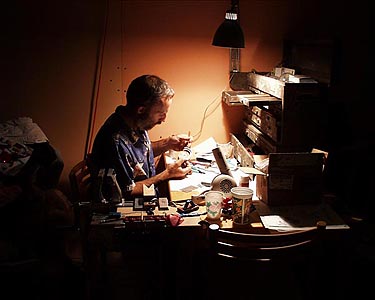
Between the first meeting with KID and our connection to NeXT, my wife and I bought a house that needed major work. We were living in the shop (former garage) and had 90% of the house torn down, including ripping out the foundation and all electrical and almost all plumbing. This photo was taken in the shop, and the kids were sleeping on the other side of the wall. The wall was ½″ gator foam. I could only use the small light or the room would be too bright. My eyes were strained to the point of aching, so I went to the eye doctor. She tested me and said, “no wonder your eyes hurt, you have no depth perception”. It turns out I do not see well in stereo due to a problem with my right eye since birth (which cannot be fixed with glasses). She thought I may have compensated all my life by processing 3D information differently than others.
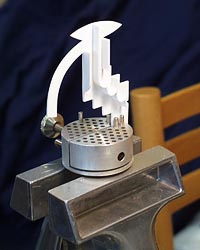
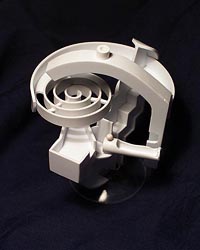
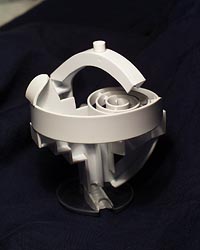
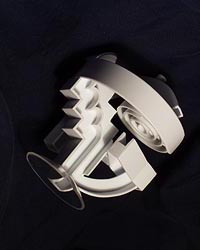
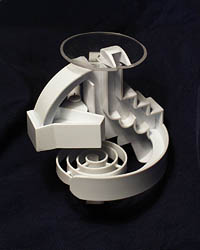
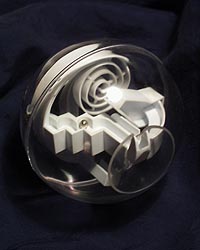
I was given three days to build the model. On Thursday evening after work, I put in four hours. On Friday, another fifteen. And on Saturday, after six more hours, the model was finished. As with the last two game models it was built from styrene. The sphere came from a Christmas tree globe kit purchased at a craft store.
“PSYCHO-PATHS” was meant to be easy to play with high railings nearly everywhere. There was going to be a timer on the bottom, allowing the player to test their speed and dexterity, rather than dexterity alone as with so many of the previous versions. I resisted the timer. It was a concept I thought about from the earliest days, but felt ill-at-ease with. The deep-down motivation expressed by KID regarding the timer was that the game would be marginalized unless it was placed on the electronics isle at the toy store. I naively thought the timer would fit within the small void in the base, flush with the exterior of the sphere. My perspective was from having taken apart cheap digital watches as a kid. Those electronics were very small. As seen in the first sketch on this page, I wanted two LCD screens listing the top score and current speed.
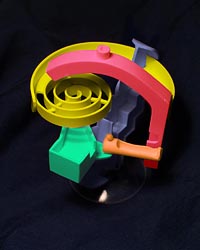
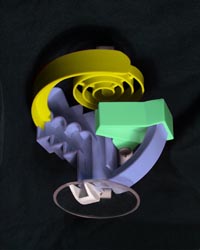
Finding the Right Name
Because of the recent Columbine shootings, the name “PSYCHO-PATHS” was eliminated. My wife always disliked that name anyway, and my only attachment to it was that “playing the game would drive you crazy!” We found a great alternative, “PLEXUS”, which is a story in itself.
Lots of alternate names were deliberated. Below is a list of keywords we used to work on naming:
- labyrinth
- tangle
- maze
- entanglement
- reticulation
- perplexity
- balance
- gravity
- skill
- deftness
- aptitude
- cabal
- inclination
- equilibrium
- dexterity
- upend
- brink
- edge
As I’m sure you can imagine, it was difficult to come up with a meaningful name. My whole family was trying to help with naming schemes, like Rollermaze, Escher’s Nightmare, Sphericon, RampRunner, Intellisphere, Exactoball, and dozens more! My wife Becky discovered “PLEXUS”. She worked from the root for “complex and perplexing”. “Plexus” means a complex, interconnected network. This was an exact description of my game.
For your entertainment, below is a list of all the names and namers who contributed to the effort. These are uncensored, so read at your own peril. Some are ridiculous or crass, and some are wonderful.
Names From Me
- This End Up!
- On The Brink
- Millennium Maze
- Over The Edge
- Psycho-Path
- Escher’s Dream
- McGinnis Maze
- Mike’s Maze
- End for End
- BalanceBall
- Equilibre Hable
- TravelBall
- HavaBall
- Sphere of Influence
- Fall-Off
- Split Second
- Split Infinity
- Orbit
- Fall Ball
- Fast Ball
- Connection
- The Passage
- The Path
- MicroMaze
- Quagmire
- Conundrum
- Vicious Circle
- Nimball
- Convolution
- Rapid Transit
- Cliff Hanger
- Struga Sphere (struga – deep place into which one may fall)
Names From Becky (wife)
- Plexus
- Baffleball
- Addiction
Name From Sam (son)
- Century Circle
Names From Frank (brother-in-law)
Each version of your mazes could be associated with a fruit and its corresponding color. With a nod to iMac’s styling. e.g.:
- Apple Turnover
- The Turnover
- Peach Turnover (With The Ramps A Peach Color)
- Cherry Turnover
- Orange Turnover
- Blueberry Turnover (With The Ramps A Beautiful Blue)
- Banana Turnover
- Lemon Turnover
- Lime Turnover, Etc.
This allows for a series of products that people will want to collect and sales of sets of mazes. This would look beautiful with the clear ball. The word turnover also subtly describes the action involved in solving the puzzle. Other suggestions:
- Rollamaze
- Rollermaze
- Rollaway
- Rollymaze
- Rollyrinth
- Rollaround
- Rollypoly
- aMAZEing
- Ramp n’ Roll
- Rolleramp
Names From Rene (brother-in-law)
- Escher’s Nightmare
- Michael’s Mind
- Michael’s Challenge
- Why Too Quay
- McGinnis Dexaball
- Zut Alors (means more or less “damn it”)
- Fnsphere
- FNBall (ef en)
- Fnmaze
Names From Mark (brother-in-law)
- Ballyrinth
- Dexterball
- Dextermaze
- Dextersphere (hard to pronounce, but worth a try)
- Lectromaze
- Sphericon
- Mikasphere
- Pathomaze
Names From Tom (brother)
- RoundRoller
- LedgeLiner
- On the Brink (from someone in my office)
- EdgeRoller
- RampRunner
- Gut Reaction
Names From Sue (sister)
- Sphere Mania
- Intellisphere
- Tilted
- Tiltmania
- Unbalanced
- PsychoBalance
Names From Betty (sister)
- Exactoball
- Exactosphere
- Exactorolliophus
- Exactocube
- Exactomazing
- Exactoblazing
- Exactoblazingball
- Evade
- Evasion
- Evolution
- Expression
- Patronage (red, white and blue)
- Steadysphere
- Sure-enough
- Suspense
- Euphoria
Names From Ray (pal/former room mate)
- friendly fire
- impact
- attenuator
- recycler
- sudden victory?
- enhanced radiation
- firezone
- firestorm
- gadgeteer
- over flight
- expletive deleted
- executive action
- Gadzooks
- goodgrief
- hanky panky
- brain flush
- intercourse
- authentic reproduction
- brain burster
- brain buster
- triage
- botheration
- thunderation
- auto-da-fe’(act of faith)
- horse feathers
- withdrawal
- brain drain
- select out
- capital punishment
- happy hunting grounds
- investigator 1
- flying fortress
- speculate
- bite the dust
- body count
- trouble bubble
- troublesome
- kamakaze
- stonewall
- interpret the mood
Names From Rich (my wife’s cousin’s husband)
- Maze craze (for the addictive personalities)
- Pathology (much less serious)
- Amazing grace (for the religious fanatic)
- Macho maze (for the manly man)
- Gay’s maze (alternative lifestyle)
- Von shlick (cool meaningless Germanlike phrase)
- on the edge
- The edge
Graphics and Package Design
Creating an idea is the first challenge. Making it into a physical object is the next. Packaging and marketing come at the end. Although I had nothing to do with marketing, that was not the case with packaging. One of the lucky aspects of working with a start-up toy company was that I was asked to do lots of projects an inventor would never be allowed to do.
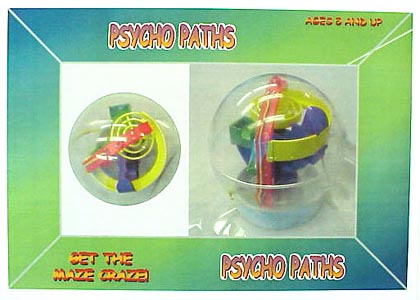
It is not known to me who worked out the graphic shown above, but it was clear that something else had to be created. I could not imagine getting this far only to be thwarted by incredibly poor graphics. It felt like the game might become like the cheapest toys found in a five and dime.
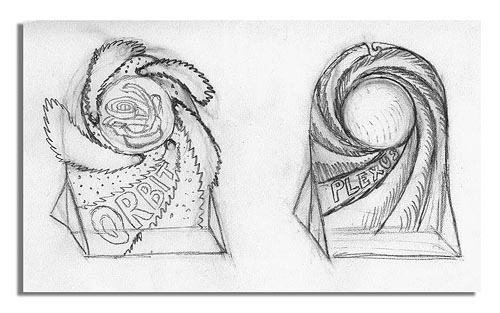
Stewart asked me to design a better package. From the first time “UP RAMP” was made in white plastic the games reminded me of a space station. I employed this theme. To me pure hues were energy producing, so a spectrum of color worked into the design. Of course movement was important to the game, so the spiral was used as well. This package could both be hung on a wall or placed on a shelf. The project was very satisfying because although I never liked doing graphics, this one rang true for me.
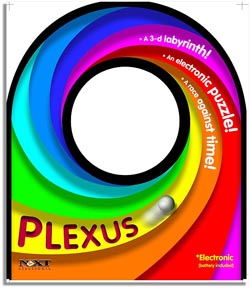
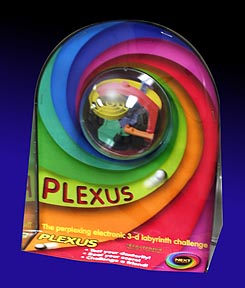
Upon approval of the initial concept, Adobe Illustrator and Photoshop were used to create print-ready artwork. Then a mockup was made using an inkjet print, acetate, and half of a Christmas globe. I do not have a better photo of the package because it was shot sitting on the drinking fountain in the art department at SRJC late on a Saturday evening. The image needed to be sent to Stewart immediately. It was so blurry and dull, I had to do lots of Photoshop work to make it become what it is here.






At this point Stewart asked me to design many packages for NeXT ELECTRONIX products, including electronic chess and several other electronic games. Also, I made an attempt to re-design the NeXT logo. Seen above is the original NeXT logo, plus my suggestions. Ultimately, he stuck with the original, which in the end didn’t matter.
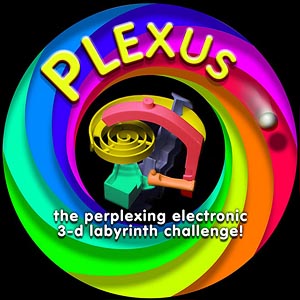
Some graphics were needed to promote the game, so the image above was produced. I don’t know if it was ever used. The toy fair was not far off, and plenty of work was being done somewhere back east and in Hong Kong. I was submitting artwork for other NeXT products as well. This was a time when I became a graphics person rather than a product designer. I was glad to have done it but even happier when it was coming to an end!
This was also the end of the name, “PLEXUS”. We were now calling it “PERPLEXUS” because it seemed more complex and perplexing. And very, very strangely, I had recently gone into the back room of the SRJC Art Gallery (where I worked as the Exhibits Specialist), and found a can of plastic cleaner called, you guessed it, PLEXUS™!
I just couldn’t believe I didn’t see it before.
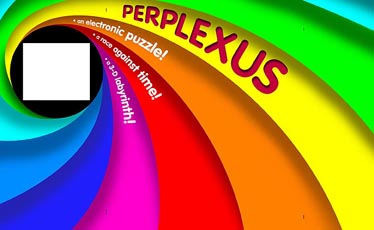
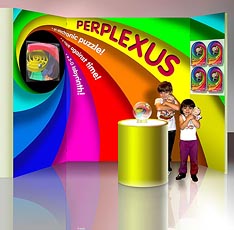
My final graphic work was to create the display booth for the American International Toy Fair, eight days away. The fair was to run from February 10th to the 17th, in NYC. It was a rush job, with one day to have it ready for the booth builders in New York. They specified that the artwork be produced full size in Illustrator (12′ wide). The image to the right was a concept montage of my kids and how the booth might look, including a lighted stand presenting the game. To the left in the image is a space for a television running a commercial! The real booth looked amazingly like this image (minus the kids).
It was time to go to New York City! Although we had no money, my wife and I scrounged the $300 for air fare and I stayed with my friend, Ray Longo, in Haskell, New Jersey. This was my first trip to NYC. Flying over the city was an amazing experience. We literally circled Central Park, and I felt as though I could reach out and touch the toy buildings (especially the Met). After taking a shuttle from LaGuardia Airport to Grand Central Station, and nearly being run down by a mean cab driver, I walked several dozen blocks to the downtown area carrying all my luggage. Everyone I spoke to along the way was friendly and helpful. The World Trade Center Twin Towers were dominant on the landscape, and I had an uneasy feeling about them, not wanting to get too close.
I was under the impression that the toy fair was in a huge convention center with 30,000 buyers, inventors, and manufacturers from all over the world gathered in a brightly lit space. I’m sure this was true somewhere in the American International Toy Fair, but not where I ended up. Playmates Toys and NeXT ELECTRONIX were on the 4th or 5th floor of an old office building, shared with a few other medium scale exhibitors. One needed a pass to enter, and mine only allowed me to get through NeXT and Playmates Toys. I was not able to see any other exhibit.
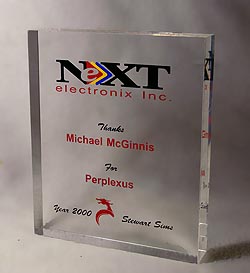
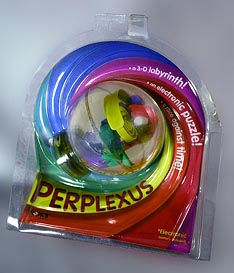
Stewart presented me with a plaque and allowed me to take one game prototype in its package. I had no time or money to get film, though I brought my camera, so I have no pictures from the trip. Stewart told me that PERPLEXUS was garnering the most attention and pre-orders out of their entire line.
Ray picked me up from the fair and we visited for a few days before my return trip to Santa Rosa. It was great to see him (he was my room-mate before I went to graduate school).
Arriving back home in California was nice because I wasn’t used to the pace, slush, cab drivers, and cold air of New York City. The people there were wonderful. San Francisco was nowhere near as dense a metropolis as NYC, and even that urbanity was 50 miles away from my home in Sonoma County.
For NeXT, the fair offered enough of a positive outlook that it was time to gear up for production. It was also necessary to begin work on another version of the game. Stewart Sims wanted to produce a whole range of “PERPLEXUS” games because a line was easier to sell than an individual model. Of course, the idea of a series was my dream.
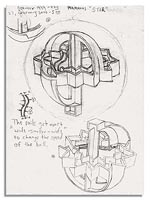
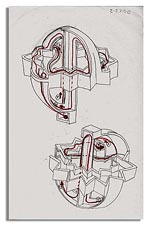
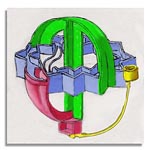
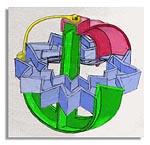
Way back in October of 1999 after I finished sketching the original “PERPLEXUS”, I began to work on a new spherical model, which I initially called “Doozie”, then “Star Track", and then finally, “PERPLEXUS STAR”. So in February, I used this as a starting point for a discussion about a second model. This version did not get past the drawing stage.
A while back KID and I discussed the possibility of going bigger with the game, and it seemed that now the timing was right.
Here is an email exchange:
(from Mike, Mar 7th, 2000) Hi all-
I’ve been working on a design for the second version of PERPLEXUS. It is based upon a 12-pointed star. Although the sketches I’ve done don’t show it, there will be TWO yellow pivot systems. Also, there will be at least one more component NOT SHOWN. This is because I’m now at the point of making the model because it is too complicated to work out all of the details in sketch form (without wasting time).
Any suggestions from KID or NeXT? Components to add, etc... I will wait for approval from Stewart before I start on the model.
Thanks! -Mike
(from Stewart Sims (president of NeXT ELECTRONIX), Mar 7th) mike,
it looks interesting, but i can’t really tell much until i see the model
stewart
(from Mike, Mar 7th) Stewart-
Sounds like I should just build it, show it to KID, modify it and send it to you for revision?
I’ll wait to see what Dan says, then work on it soon. -Mike
(from Stewart, Mar 7th) good plan.
thanks,
stewart(from Mike, Mar 8th) Stewart-
This coming Monday I’m going to meet with Dan, et.al. at KID to go over the issues you discussed with them in New York. We can develop strategies regarding Perplexus and related concepts. They will look at sketches and then I’ll make a model. I didn’t get to speak to you much at the toy fair so I am curious about what you guys discussed. As usual, I find this all very exciting!
I’ll let you know what comes up- Mike
(from Stewart, Mar 8th) didn’t really discuss much in detail, but general discussion was how to take, what we all hope will be a success, and extend it to next year.
bigger puzzle?
same size puzzle?
smaller puzzle?and what we thought were the elements that made perplexus seem so strong.
design and animation.
stewart
(from Dan Klitsner (founder of K.I.D., in S.F.), Mar 8th) Mike-
In looking forward to our Monday meeting here’s some possible avenues to explore stimulated by our meeting with Stewart:
- 1. Think Big! ...as in a larger size SuperPlexus or Su-Perplexus or...you get the idea. Something 6 or 7 inches in DIA that perhaps docks in a tabletop base which houses the electronics.
- 2. Think different... Same scale as original but provide a very new experience - not just a variation on the original maze in a sphere. For example, maybe a vertical tube with several pivoting arms that form a kind of moving ladder. It might then be marketed as “Perplexus Ladder” or some other secondary modifier that relates to the brand new challenge. The star shape may fit into this as long as the maze has an obvious point of difference.
See you Monday-
Dan(from Mike, Mar 8th) Dan-
I’m intrigued by both concepts: larger/different. I’ll put some thought into it before our meeting. It would be wonderful to make the Superplexus! The model can be rolled in the stand like a mouse trackball. Thinking differently... lots of complex pivots at different angles and relationships... carrying the ball in unpredictable (but defined) paths... or something else that moves along instead of a ball, like a barbell form or weighted and inverted “U” shape.... Interesting!
See ya on Monday- Mike
(from Gene Morra (vice president of NeXT Electronix), Mar 8th) Guys,
All great directions!
Gene
(from Gene, Mar 8th) Gentlemen,
Off the top of my head, I would like to see the puzzle increase in complexity and geometric while still embracing the elements that made the original successful. Perhaps is goes from a ball to a shape I have seen that looks like several balls intersecting (I don’t know the name of it).
Or perhaps it has more internal part that move or interfere with play like pendulums). Nice extensions could simply change shape and the name gets a modifier: The shape changes to a cube and the name is Perplexus (to the third power). I am sure that whatever shape it takes on, Perplexus must be in the name.
There are many possibilities
Gene
(from Mike, Mar 9th) Gene-
Are you thinking of a transparent globular form as a container? How about with four intersecting spheres; like a spherized tetrahedron. (like the shape that 4 equally-sized soap bubbles form if connected in mid air).
The pendulum idea is cool. Maybe it is set in motion by a simple electronic pulse from an electromagnet... or just by the motion of turning the toy while going through the pathways. If it is a timed motion, then there can be a real chance to get through it while it is out of the way. Otherwise, a tempo on a miniature pendulum would be super fast.
Here is a pivot idea: a curved scoop with open ends that is hung from the middle like a pivot that swings side to side. It becomes aligned with the appropriate track just by careful placement and not stops (as exist on the first Perplexus). The ball can exit the other end of the scoop when it is aligned with another track. Or here is a variation: the same concept, only the pivot/scoop is attached to a ribbon-like mechanism that when wound around a central shaft, raises and lowers its position (like a yo-yo string, or rope around a winch). Difficult to describe, so I better draw it.
How about crossing gates that block the path unless you tip the container properly. Or side rails that fold out of the way periodically!
This is when the fun stuff starts... Have a good one -Mike
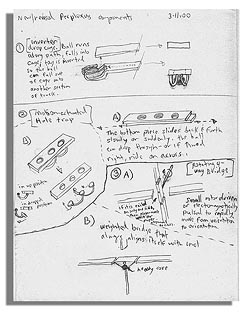
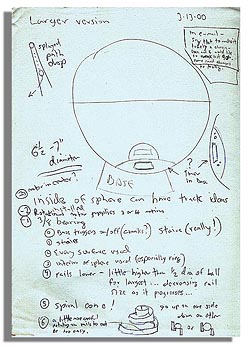
On Saturday, March 11th, I did a preliminary sketch describing my ideas mentioned in the email exchange. That following Monday in San Francisco, Dan and I met to discuss things. The drawing (above right) is the result of our meeting. There were several notes written on it. One says, “in email – say that to make it truly a classic – Dan and I would like to tweak just 10%. Some small changes to tooling”. This applied to the smaller “PERPLEXUS”. Then there was the list of ideas and possible components to combine in the big version:
- splayed path drop
- 6-1/2″ to 7″ diameter
- timer in base
- motor in center?
- rotating motor supplies 3 or 4 motions
- 3/8″ bearing
- base triggers on/off
- stairs (really!)
- every surface used
- interior of sphere used (especially ring)
- rails lower- little higher than 1/2 diameter of ball for largest... decreasing rail size as it progresses...
- spiral cone!
- a little more careful detailing on rails to not be too easy, go up one side, down the other
This was as far as we took “SUPERPLEXUS” at the time because the original “PERPLEXUS” needed to get into working order first. There were many problems with fit and finish to address.
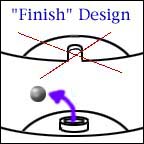
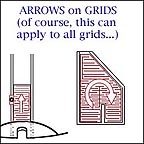
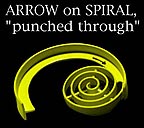
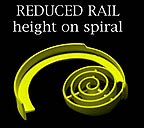
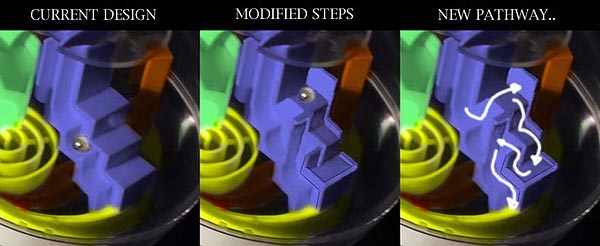
Below is the email Dan asked me to write regarding changes to “PERPLEXUS”, illustrated in the images above. Then we played a waiting game, which was not very entertaining. It took nearly three months for us to receive functioning samples to review.
Perplexus needs a few simple modifications to improve its panache. Listed are some simple steps which either MUST be done or CAN be done:
MUST DO-
- The FINISH exit needs to be made so the ball can’t easily go into it from the exit. This can be accomplished easily by making a short raised "tube" rather than the open cut area as is now on the START and FINISH. Please see attachment, “finish_design.jpg”, below.
- The electronic “contact grids” must not be so easily affected by gunk (dirt) as is the case with the prototypes. When the ball rolls on them, the timer is not always triggered because the ball has telegraphed residue from the track to the grids. Is this problem going to be solved when the actual thermoplastics are used instead of the painted plastic in the prototypes?
CAN DO-
- Can the “contact Grids” be replaced with wires that act as conductors which receive a drop in voltage (minute) when the ball passes close by, thus triggering the timing circuit? This could eliminate the gunk problem, and a possible corrosion problem over time.
- If you keep the existing “contact grid” concept, ARROWS indicating the direction of travel can be designed into them. Please see the attachment, “arrows_on_grids.jpg”.
- There can also be arrows in a few other locations such as on the yellow SPIRAL. These can be of a “punch through” design, meaning it can be a “hole”. It can point the direction on both sides simultaneously. See attachment, “arrow_on_spiral.jpg”. This can apply to other appropriate areas as well, such as the larger sweeping curved section on the BLUE component.
- A few rail heights can be adjusted. The yellow SPIRAL can have lower rails as seen in, “reduced_rail.jpg”. This can both improve the sleekness and make the game more challenging. The rail can also be lowered on the reddish/orange CUP to make it easier to see into.
- A minor set of modifications in the BLUE component can allow the player to utilize the “steps” that are currently not accessed. This is illustrated in the image entitled, “steps.jpg”.
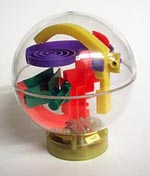
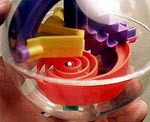
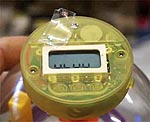
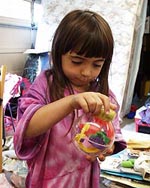
Finally, a production sample arrived. It was not good for it to arrive on a Saturday, since no one works on the weekend. Unfortunately, none of our suggestions for improvement were addressed. I had a difficult time with the base, colors, timer, connection methods, my own design, you name it. The parts with no fitting problems were far too easy to play. Then the metal contacts failed, the timer broke, and the ball got jammed in a few spots. Plus it was easy to cheat. Otherwise everything went well.
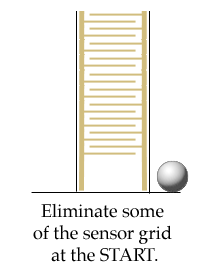
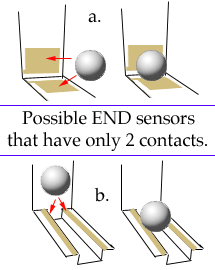
On Monday I sent an email regarding the sensors and other issues. Dan Klitsner, who was also reviewing the production samples, agreed to meet on the following Thursday after my class.
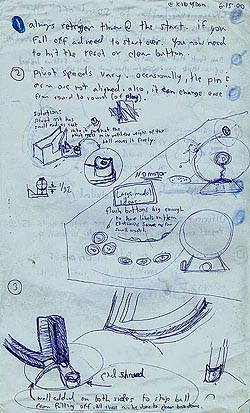
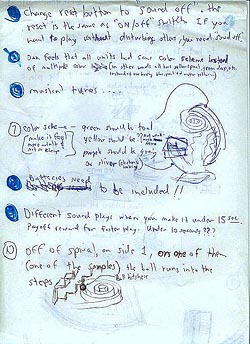
Dan and I went over the problems thoroughly. Below is a list of problems and solutions. My writing was a bit messy, so I don’t guarantee accuracy.
- Always retrigger timer at the start. If you fall off and need to start over, you now need to hit the reset or clear button.
- Pivot speeds vary. Occasionally the pin and arm are not aligned. Also it can change ease from round to round of play. Solution: pivot rest has small radius cut into it so that the pivot rests on it until the weight of the ball moves it freely.
- End Shroud. Wall added on both sides to stop ball from falling off. All these can be done to clear base dome.
- Change reset button to “sound off”. The reset is the same as “on/off” switch. If you want to play without disturbing others, you need sound off.
- Dan feels that all units have same color scheme instead of multiple color (in other words, all have yellow spiral, green drop, etc., instead of having one blue spiral and another yellow).
- Musical tunes....
- Color scheme. Green should be teal. Yellow should be not weak- maybe neon. Purple should be gray or silver (electronic looking). Make it feel more adult and not so cheap.
- Batteries need to be included!!
- Different sounds play when you make it under 15 seconds. Payoff reward for faster play. Under 10 secs???
- Off of spiral on side one, on one of them (one of the samples), the ball runs into the steps. Ball hits here.
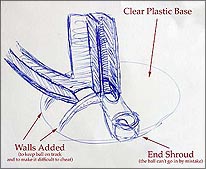
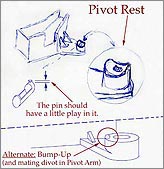
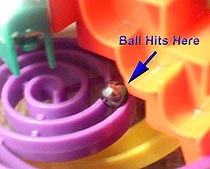
These were the last corrections KID and I were able to make. We stopped getting emails or contacts from Stewart Sims. Dan Klitsner told me that Stewart was no longer a part of NeXT. Something happened with the use of available resources at Playmates Toys and everything went topsy-turvy (hey, that’s an interesting name idea!). So from then on, NeXT ELECTRONIX was no more. All of our work in the hands of NeXT was boxed up and sent to another subsidiary of Playmates Toys. They didn’t even open the boxes, and had no interest in “PERPLEXUS”.